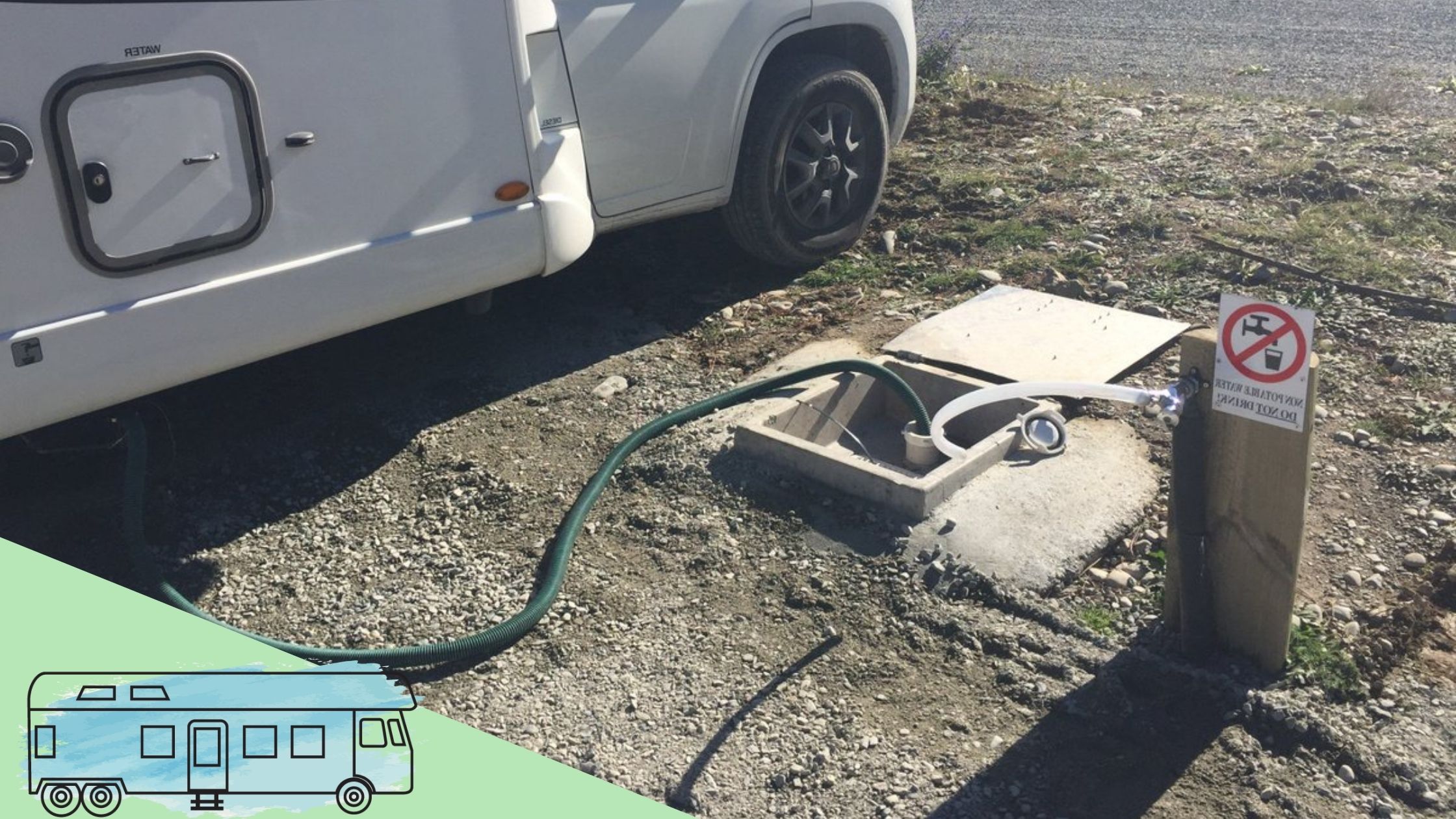If you’re traveling with a self-contained vehicle, you must dump your grey waste in an environmentally sound and safe way at a designated dump station. Most campervan companies suggest disposing of grey waste every 2 to 3 days.
Greywater tends to slander the image of RV travelers, that’s pretty obvious. A safe and responsible disposal has always been challenging for the travellers. Although grey water is not as harmful as the black water, it too has some negative effects on the environment and human health. For these reasons, water management during travels is very important. In this post, I have covered everything you need to know about a responsible grey water disposal in New Zealand.
So, if you want to know more, keep reading!
You can dispose of greywater in New Zealand in three ways. 1: On most camping sites; 2: non-camping facilities and public dump stations often near gas stations, and; 3: On the ground as long as you follow the local council’s guidelines. These will include maximum daily volume, distance to any surface water body, water supply coastal marine area, and the requirement to no runoff from the disposal area.
What is grey water?
For those who don’t know, water is classified as white, black and grey water. Here white water is the unused, clean and fresh water. And once it is used in showers, sinks, dishwashers and other things except for toilets, it is considered as grey water. Also, the filthy stuff from the toilet is categorized as black water. There are basically two separate tanks in most RVs for collecting grey and black waters. However, both get mixed at dump stations.
Is grey water toxic?
Grey water as such is not as toxic as black water because it has minimum pathogens in it. However, when it is stored for more than 12 to 24 days, it becomes very harmful.
Below are some of the negative effects of grey water :
On human health
As we already discussed, black water has the highest concentration of pathogens in it and hence it is very toxic. When ingested unknowingly, it can even cause life-threatening situations. The point is when grey water is stored for a longer time, it starts breeding harmful bacteria and turns into black water.
Attracts pets and diseases
Harmful insects and pests are attracted to dirty waste water. These pests then spread numerous dangerous diseases.
Contaminate waterways
This is perhaps the biggest reason why you should always dispose of waste water responsibly. Both grey, as well as black water, should never be allowed to enter the fresh water sources. The toxic compounds present in waste water can kill aquatic life. Moreover, excess nutrients can result in algal bloom, which is another great problem. For these reasons, grey water shouldn’t be dumped into swimming pools, lakes, rivers etc.
Develops foul smell
Need I say more? Grey water when collected for longer results in a very disgusting smell which can trouble you like anything.
Damages flora
While there is no harm in disposing of grey water near plants occasionally, the chemical in it can be harmful for the plants in the long run.
Can lead to soil erosion
Grey water dumped in the wrong areas can result in soil erosion and may affect the site users and nearby water sources.
What should you do to minimize the harmful effects of the greywater?
As a responsible citizen, there are mainly three ways in which you can minimize the harmful impacts of waste water :
- Minimize your water usage
- Keep your water clean
- A safe and responsible disposal
Minimize your water usage
Below are a few tips on how you can reduce your water utilization :
- Use local water. This means consider using park toilets, showers, laundry, cooking, and washing facilities
- Consider having showers on alternate days. It may sound a bit weird, but if you’re a traveler, say no to daily showers. Instead, use antibacterial wipes and sprays to keep yourself clean and fresh. Also, while you use a shower, keep the taps off when using soap. Avoid long showers at all. The best idea is to find a river or ocean and take a fresh dip!
- Don’t allow taps to run unnecessarily. For example: while brushing, using soap, etc.
- Use grey water for flushing the toilets
- Avoid washing clothes regularly while traveling. You can also wash your clothes using shower water
- Avoid water-intensive cooking. Steam your food instead of boiling
- Give your utensils a good scrap to remove as much food scraps as you can before washing them
Keep your water clean
Here is how you can keep your greywater less toxic to the environment :
- Reduce the number of food scraps
- Before washing and rinsing the dishes, wipe them nicely using old newspapers or waste cloths. Avoid using a lot of paper towels and help nature.
- Use a fine mesh or your old stocking to filter grey water in your sinks /wash areas. This will collect the solid waste which you can dump into your trash can.
- Don’t allow oils and fats to get mixed with grey water. Instead of dumping the extra oils and fats, consider reusing them for further cooking or fill them in a sealable can and dump them into your garbage can. Oils and fats can result in blockage in the drains, septic tanks and can also damage the pumping mechanisms.
- Use eco-friendly products. There are plenty of environment or grey water-friendly products you can use for laundry, dishwashing, toilets, bathing, and other cleanings. These products are biodegradable and don’t contain harmful chemicals that degrade the environment.
- Use septic-friendly products. If you don’t use septic-friendly cleaning products, you’re unknowingly killing the community of bacteria present in the septic tanks. This bacteria community is very crucial for a well-functioning septic system as it helps in decomposing the waste. Therefore, use septic-friendly detergents, soaps, and other cleaning products.
Safe and responsible disposal
Now that you’ve minimized your water usage, kept your resulting grey water as clean and possible, the next important step is to dispose of it in a responsible manner. Always dump your grey water at the specified dump stations you’ll come across during your travels.
When you’re on a trip, you may find one site that has a well-functioning dump station, the next may allow you to dispose of your waste water on a piece of ground. Or some may allow you to fill your grey water in buckets and empty them in the vegetation or may instruct you to take your self-contained vehicle for off-site disposal without leaving any traces of stay. I hope you got an idea, the disposal of grey water depends on the place you’re in.
Can I dump grey water on the ground in New Zealand?
As we already discussed above, it depends on the location where you’re staying. Some sites allow travelers to dispose of their water on an appropriate piece of land in New Zealand. However, this is not the same for all the sites. So, a good idea is to look at the water management rules of the place you’re staying. Also, to be on the safe side and to behave responsibly, always look for a nearby dump station and if there is no dump station, consider dumping your grey water in the toilets.
As an example in Wellington, you can dump grey water on the ground as long as you adhere to certain guidelines
The discharge of greywater onto or into land is a Permitted Activity provided the discharge
(a) does not exceed a maximum daily volume of 2000 litres;
(b) is more than 20 metres from any surface water body, farm drain, water supply race, or the coastal marine area; and
(c) does not cause ponding on, or runoff from the disposal area.
Source: Weillington Regional Counsil
Many people will suggest using greywater for watering the plants, but I won’t recommend that. The reason is, plants may withstand greywater occasionally but it will surely harm them in the long run. The chemicals from detergents, soaps, and other cleaning agents can be very toxic to the health of plants.
Where and how to find dump stations in New Zealand?
Finding a nearby dump station in New Zealand is not as hard as it sounds. A majority of campgrounds here have their own dump points and you’ll get public ones throughout the nation.
Here is how you can find a nearby dump point in New Zealand:
Using an online AA map
The easiest and perhaps the handiest way is using an AA map. All you need to do is open the aa map and search for the nearest dump points, the map will provide you with the directions of the nearest facilities.
Using applications
If you’re traveling in New Zealand, the camping NZ app will be very helpful for you. Not only it will help you in locating the nearest dump point, but it will also guide you to the other facilities as well.
Look for dump station symbol
Keep your eyes open for the dump station symbol which is blue in color and will be seen frequently throughout the country.
 Also, a majority of public dump points are located near the petrol and gas stations.
Also, a majority of public dump points are located near the petrol and gas stations.
So, this is how you can easily find a nearby dump station during your trip to New Zealand. Most of these facilities are easy to access and are free as well. If you’re traveling in an rv or campervan, make sure to use the dump station that suits your vehicle size. Also, don’t forget to drop a few coins in the donation boxes if placed beside the dump point, this small contribution helps in the maintenance of these facilities.
This was all about “How to get rid of greywater in New Zealand”, I hope this article helps you.


